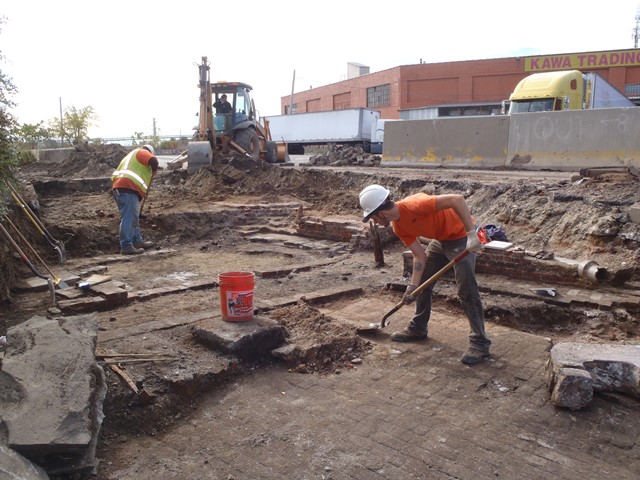Yep, you’re reading that right: the Pennsylvania Department of Transportation (PennDOT) does archaeology!
Public perceptions of PennDOT can run the gamut from potholes to plow trucks. If this is your first time reading about archaeology at PennDOT, that’s because we have not always been very good at talking about it. We know that and we’re working on it, along with your potholes, in a variety of ways!
PennDOT’s Cultural Resources program is the largest public-sector preservation and archaeology program in the state and we do more archaeology than any other public agency in the state! Department archaeologists talk about archaeology among ourselves all the time. We regularly publish in professional journals and we produce legally required technical reports, but it’s harder for us to translate the highly technical work we do for the general public.
Gallery page of the Digging I95 website, http://diggingi95.com/tag/gallery/
Archaeology is not alone in this and public outreach is an increasing focus of many sciences in recent years. That’s ironic because the public is ultimately why we pursue archaeology; we want to add to our shared knowledge of the peoples of the past. Everyplace has a past, and the past belongs to everyone. I can assure you, transportation archaeologists are not in it for the riches or for adventures that land us in a booby-trapped temple of doom. If anything, we’re in it because we, yes, the collective we, have a lot to learn from our past.
Why?
Good question! We get that a lot.
There are a couple of reasons why we do archaeology at PennDOT. Our reasons range from legal obligations (referenced below if you’re interested) to providing people with safe and reliable transportation, while also maintaining the quality of life that the historic preservation of our communities provides.
While we’ve always known people thought archaeology was cool, we now know that they also believe in its importance. In a recent poll released by the Society for American Archaeology and Ipsos, 93% of Americans say that “the work archaeologists do is important. More than half believe the US should increase funding for archaeology and enact stronger laws to protect sites and artifacts”. You can read the full report of the survey here if you’re interested: https://documents.saa.org/container/docs/default-source/doc-publicoutreach/ipsos_poll2018.pdf?sfvrsn=a1f0921e_4.
Results from the 2018 SAA and Ipsos Poll. Source: https://www.saa.org/education-outreach/public-outreach/public-perceptions-studies.
Not only is the public interested and supportive, they learn about archaeology from a variety of sources including classrooms and textbooks (58%), museums (57%), television (56%), movies (36%), print media (29%), popular books (25%), online new (18%), public events or lectures (12%), and social media (12%) (SAA and Ipsos 2018). Our past public outreach efforts, and these recent results, suggest ways we can do better at providing the public with a glimpse of the past beneath their feet (and their highways!).
Archaeology as Public Outreach at PennDOT
Archaeological investigations at PennDOT regularly result in the production of dense and highly technical reports, which are available to the professional community via the PA SHPO’s CRGIS website. Our larger-scale efforts generate more public-focused products like school curricula, local and state museum exhibit designs, our Byways to the Past booklet series, websites like the Journey to Potters Mill Story Map and Digging I-95, and lectures and presentations.
Screenshot from the Story Map showing “A Bird’s Eye View of Potters Mills”, a historic photograph provided by the Centre County Historical Society.
In 2018, we took on public outreach via social media. PennDOT and McCormick Taylor Associates in coordination with Heberling Associates developed a three-part series of short, social-media friendly videos linked below:
- Transportation and Archaeology – https://vimeo.com/298230272
- How is an Archaeological Study Completed? – https://vimeo.com/301604402
- Digging Deeper into Archaeology: Tribal Connections – https://vimeo.com/296622502
Developed as part of mitigation for a project, the series aims to provide easily accessible, interesting, and shareable material for the general and interested public. In coordination with the Federal Highway Administration, PA SHPO, Pennsylvania Archaeological Council, and Federally-Recognized Tribes and Nations (the Delaware Tribe, the Eastern Shawnee Tribe of Oklahoma, and the Seneca Nation), the focus of the videos is sharing the results of archaeological investigations and how they inform our knowledge of past peoples.
Resources:
As part of PennDOT policy (PennDOT Publication 689) to develop timely transportation plans, programs and projects, we also seek to balance social, economic, and environmental concerns. Archaeology at PennDOT is done under the auspices of a number of notable governing laws and regulations, both state and federal.
The primary players in terms of pertinent legislation for archaeological survey at PennDOT include:
Take a look at the Society for American Archaeology’s 2018 Ipsos American Perceptions of Archaeology Poll for more information.
Today’s post is by guest author Angela Jaillet-Wentling. Angie Jaillet-Wentling is a Historic Preservation Specialist for the Pennsylvania Department of Transportation (PennDOT) specializing in archaeology. She covers seven counties in southwestern Pennsylvania’s Engineering Districts 11-0 and 12-0. You can reach her at ajailletwe@pa.gov.
Comment Policy
PHMC welcomes and encourages topic-related comments on this blog. PHMC reserves the right to remove comments that in PHMC’s discretion do not follow participation guidelines.
Commenters and Comments shall be related to the blog post topic and respectful of others who use this site.
Commenters and Comments shall not: use language that is offensive, inflammatory or provocative (this includes, but is not limited to, using profanity, obscene, or vulgar comments); disparage other commenters or people; condone illegal activity; identify the location of known or suspected archeological sites; post personal information in comments such as addresses, phone numbers, e-mail addresses or other contact details, which may relate to you or other individuals; impersonate or falsely claim to represent a person or an organization; make any commercial endorsement or promotion of any product, service or publication.
If you would like to comment on other topics not related to this blog post but related to PHMC, please fill out the PHMC Contact Us Form.
